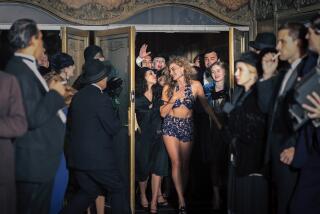Lynn Bari; Sultry Star of Many Films in 1930s, ‘40s
- Share via
Lynn Bari, the husky-voiced siren who starred in dozens of films of the 1930s and ‘40s, usually as “the other woman” in low-budget pictures for 20th Century-Fox, has died in Goleta, it was learned Thursday.
Daily Variety, the entertainment newspaper, said she died Nov. 20.
A spokeswoman for Goleta Valley Community Hospital confirmed Miss Bari’s death of cardiac arrest and said she had listed her age as 69. But several film anthologies show she was born in either 1913 or 1915.
Whatever her age, she came to pictures as a youthful chorine after moving to Los Angeles with her minister-stepfather from Boston, where she was raised.
Statuesque and darkly beautiful, she was first seen in “Dancing Lady,” a 1933 musical in which a young Broadway dancer named Fred Astaire also made his film debut.
She was born Marjorie Fisher in Roanoke, Va., but after taking acting lessons here she changed her name. She said in a long-ago interview she had devised “Lynn Bari” by combining the names of actress Lynn Fontanne and author Sir James M. Barrie.
After appearing in such now-forgotten pictures as “Stand Up and Cheer,” “Thanks a Million,” “Sing Baby Sing” and “Return of the Cisco Kid,” Fox ballyhooed her as a future star in 1940, giving her a long-term contract along with such other young hopefuls as Linda Darnell, Gene Tierney, Cobina Wright Jr. and Mary Beth Hughes.
The quality of her pictures improved for a time and she was cast in two musicals featuring the legendary Glenn Miller band, “Sun Valley Serenade” and “Orchestra Wives.” But with the exception of “The Bridge of San Luis Rey” in 1944, she was never again featured in the quality parts she sought.
She told Times drama editor Edwin Schallert in 1944 that she felt she was consigned to perfunctory roles because “. . . I worked in so many melodramas” and “. . . acquired a certain rugged experience and technique in cops-and-robbers films.”
Until 1968, when she made her final picture, “The Young Runaways,” she continued to portray slinky villains or secondary leads in “China Girl,” “Home Sweet Homicide,” “I’d Climb the Highest Mountain,” “Has Anybody Seen My Gal” and several more.
Still lithe and slim into the late 1960s, she tried a brief stage career after receiving complimentary reviews in an extensive tour as “The Gingerbread Lady” and as a star of “Barefoot in the Park,” but then retired to the Santa Barbara area near her son John.
He had been the subject of a stormy custody fight between Miss Bari and her second husband, Sid Luft, who later married Judy Garland. Her first husband was Walter Kane, an agent, and her third was Dr. Nathan Rickles, a Beverly Hills psychiatrist. She worked for a time as his nurse. They divorced in 1972 after 17 years of marriage.
Daily Variety reported that her ashes were scattered at sea.
More to Read
Only good movies
Get the Indie Focus newsletter, Mark Olsen's weekly guide to the world of cinema.
You may occasionally receive promotional content from the Los Angeles Times.










